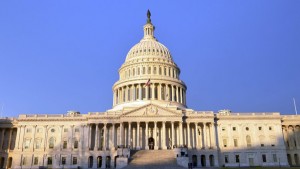 Jonathan Turley – Below is my column in the Hill Newspaper on why the legal challenge filed against the Trump Administration byNew York Attorney General Eric Schneiderman (left) and others over the rescinding of DACA. As discussed in the article, I have been a long critic of the executive orders issued by President Barack Obama to achieved unilaterally what he failed to achieve legislatively. Notably, Sen. Dianne Feinstein (D-CA) has acknowledged that DACA was on shaky legal ground. Notably, CNN host Chris Cuomo observed:
Jonathan Turley – Below is my column in the Hill Newspaper on why the legal challenge filed against the Trump Administration byNew York Attorney General Eric Schneiderman (left) and others over the rescinding of DACA. As discussed in the article, I have been a long critic of the executive orders issued by President Barack Obama to achieved unilaterally what he failed to achieve legislatively. Notably, Sen. Dianne Feinstein (D-CA) has acknowledged that DACA was on shaky legal ground. Notably, CNN host Chris Cuomo observed:
“There’s no question it’s been legally dubious from jump,” Cuomo said at the end of their conversation. “Nobody’s going to argue with that in a very compelling fashion. At least not this morning, but it’s also about what are you going to do for these people. This is a moral argument, not just a legal one.”
However, it is a dangerous thing to take moral exemptions from the constitutional process because it leaves the question of who decides which issues will be given a constitutional pass. This is an argument that can be made to the legislature but it is important to maintain the clear lines of separation between the branches in the creation of new legislation. DACA was a legislative act done by executive order in my view.
Given the intense political dynamic that led to the issuing of the DACA order, the courts will be necessarily leery of a violation of the political question doctrine in being asked to intervene. The Complaint does contain a couple claims that a court could find compelling but these claims are at most likely to delay rather than prevent deportations. However, as I discuss, complaints like people are often painted by first impressions and the first impression in this complaint (which starts with an ill-supported equal protection claim) is not flattering.
Here is the column: The long-anticipated lawsuit to block the termination of the Deferred Action for Childhood Arrivals (DACA) program was filed in New York with the equally-anticipated frenzy of media coverage and political posturing. State attorneys general from 14 states and the District of Columbia assured those protected by DACA that they were moving to protect them against what New York Mayor Bill de Blasio called a “profoundly racist” President Trump. New York Attorney General Eric Schneiderman denounced the DACA decision as the “culmination” of Trump’s “oft-stated commitments — whether personally held, stated to appease some portion of his constituency, or some combination thereof — to punish and disparage people with Mexican roots.”
The lawsuit itself, however, is long on rhetoric and short on law. Indeed, the lawsuit appears appeared designed to more to “appease” supporters than convince judges. There is a disturbing disconnect between the public descriptions and the actual claims in this complaint, leaving many with a false impression, and perhaps false hope. Even if successful, half of the claims would not materially alter the outcome for Dreamers. Where Schneiderman described Trump’s decision as “gratuitous,” the same description could be leveled against much of this complaint.
From the start, any challenge faced the obvious difficulty in arguing that Trump is barred from using the same authority to rescind DACA that President Obama used to create it. The challengers, therefore, needed to show the federal court that they had serious legal objections rather than policy disagreements with the current administration. Federal courts follow the “political question doctrine,” which bars the ruling on political as opposed to legal disputes.
Despite this threshold concern, the challengers spent page after page disparaging Trump for everything from his comments about violent illegal immigrants to his failure to condemn a past case of a Mexican abused by his supporters to his pardoning of former Sheriff Joseph Arpaio. If a judge was concerned that this was a political dispute before the filing, that concern would likely become a conviction halfway through the complaint.
When the challengers do get to plausible legal claims, concern turns to confusion. I often tell my students that complaints are the ultimate example of the importance of “first impressions.” For that reason, you start with your strongest and most unassailable claim. If so, this first impression is decidedly bad. The challengers lead with a politically popular but legally dubious claim under the Equal Protection Clause of the U.S. Constitution. As Massachusetts Attorney General Maura Healey explained, you need a “valid, a law justification” and “animus cannot provide such a justification.”
The problem is that there is such a valid justification entirely separate from any alleged racial animus. For more than eight years, various experts (including myself) raised serious constitutional concerns over the unilateral actions taken by Obama in immigration and other fields. That basis was the justification given by Attorney General Jeff Sessions and raised in prior litigation. Some 25 states previously challenged the closely-related program of Deferred Action for Parents of Americans and Lawful Permanent Residents (DAPA). It was found to violate federal immigration law, which “flatly does not permit” deferred action. A significant number of members of Congress blocked DACA in Congress, long before Trump ever uttered a word of a wall or “bad hombres.” That may not be a justification that Healey likes, but it is a valid and legal one.
The other counts offer legal but likely ineffectual grounds to block deportations. The challengers raised issues of privacy and procedure that, even if successful, would not likely alter the outcome if Congress decides that it will not extend the protections. The complaint objects to the use of information supplied by those who registered under DACA. However, even if ripe for review, a judicial order protecting the information would not prevent any deportation.
The complaint also challenges the decision under the Administrative Procedure Act (APA) for failing to follow the process for notice and comments. However, Obama himself called DACA a “temporary stopgap” and his Justice Department warned that it “could be terminated at any time at [the Homeland Security Department’s] discretion.” Moreover, the APA analysis will collide with the statement of former Homeland Security Secretary Janet Napolitano that “this memorandum confers no substantive right, immigration status or pathway to citizenship” because “only the Congress, acting through its legislative authority, can confer these rights.” Finally, the key noun in the APA is “procedure.” Even if successful (and there are grounds to contest the applicability of the law), it would merely delay but not prevent deportations.
Assuming these barriers can be overcome, a victory under the APA could prove something of pyrrhic victory. The problem is that Obama did not believe that DACA had to satisfy the APA and did not offer a notice and comment period. Indeed, in the related DAPA decision, the Fifth Circuit ruled that the Obama administration violated APA among other flaws in the program. So, in arguing that the decision rescinding DAPA must satisfy the APA, the challengers would also be saying that DAPA itself is invalid for failing to do so. The same is true for the challenge under the Regulatory Flexibility Act, which (if true) would be equally damaging for DACA itself. It is the legal equivalent of the Vietnam strategy of destroying a village to save it.
In the end, the challengers are hoping to literally trump the legal analysis with the president himself. D.C. Attorney General Karl Racine insisted that “we think there are enough references to his comments, both before he was president and while he was president, that illustrate a bias against Mexicans.” The courts will have to decide if they are also willing to create a new form of the “temporary restraining order” sought in these challenges. The “Trump restraining order” would certainly be liberating for critics but would leave little of the law in its wake.
Jonathan Turley is the Shapiro Professor of Public Interest Law at George Washington University. You can follow him on Twitter @JonathanTurley.
SF Source Jonathan Turley Sep 2017


 “NO MORE DACA DEAL!” Trump wrote, referring to Deferred Action for Childhood Arrivals, the immigration policy that provides legal status to dreamers.
“NO MORE DACA DEAL!” Trump wrote, referring to Deferred Action for Childhood Arrivals, the immigration policy that provides legal status to dreamers. Will Racke – A group of Republican lawmakers unveiled Wednesday a bill that pairs granting legal status to younger illegal immigrants with a laundry list of conservative immigration reforms and border security enhancements, including President Donald Trump’s proposed border wall.
Will Racke – A group of Republican lawmakers unveiled Wednesday a bill that pairs granting legal status to younger illegal immigrants with a laundry list of conservative immigration reforms and border security enhancements, including President Donald Trump’s proposed border wall. Jonathan Turley – Below is my column in the Hill Newspaper on why the legal challenge filed against the Trump Administration byNew York Attorney General Eric Schneiderman (left) and others over the rescinding of DACA. As discussed in the article, I have been a long critic of the executive orders issued by President Barack Obama to achieved unilaterally what he failed to achieve legislatively. Notably, Sen. Dianne Feinstein (D-CA)
Jonathan Turley – Below is my column in the Hill Newspaper on why the legal challenge filed against the Trump Administration byNew York Attorney General Eric Schneiderman (left) and others over the rescinding of DACA. As discussed in the article, I have been a long critic of the executive orders issued by President Barack Obama to achieved unilaterally what he failed to achieve legislatively. Notably, Sen. Dianne Feinstein (D-CA)